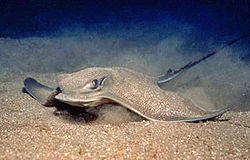Eagle ray
Eagle rays are cartilaginous fish in the ray family Myliobatidae. They are mostly large species living in the open ocean rather than on the sea bottom.
| Eagle ray Temporal range:
Upper Cretaceous to Recent | |
|---|---|

| |
| Spotted Eagle Ray, Aetobatus narinari | |
| Scientific classification | |
| Kingdom: | |
| Phylum: | |
| Class: | |
| Subclass: | |
| Superorder: | |
| Order: | |
| Suborder: | |
| Family: | Myliobatidae Bonaparte, 1838
|
Eagle rays feed on molluscs and crustaceans, crushing their shells with their flattened teeth, while devil rays and manta rays filter plankton from the water.
They are excellent swimmers and are able to breach the water up to several metres above the surface. Compared with other rays, they have long tails, and well-defined diamond-shaped bodies. They are ovoviviparous, giving birth to up to six young at a time. They range from 48 centimetres (19 in) to 9.1 metres (30 ft) in length.[1]
The tail looks like a bull whip and may be as long as the body. It is armed with a sting. Eagle rays live close to the coast in depths of 1 to 30 metres and in exceptional cases they are found as deep as 300 m. The eagle ray is commonly seen cruising along sandy beaches in very shallow waters.[2]
Classification
In Nelson's Fishes of the World, the eagle rays are a subfamily, and are joined by the manta rays and the eagle rays. As Nelson sees it, there are seven genera in the family, in three subfamilies.[3] In our classification, the three groups are families in the suborder Myliobatoidei.
Eagle Ray Media
References
- ↑ Froese, Rainer, and Daniel Pauly, eds. 2009. "Mylobatidae" in FishBase. FishBase online
- ↑ Long, John A. 1995. The rise of fishes: 500 million years of evolution. University of New South Wales Press.
- ↑ Nelson J.S. 2006. Fishes of the World. 4th ed, Wiley.

